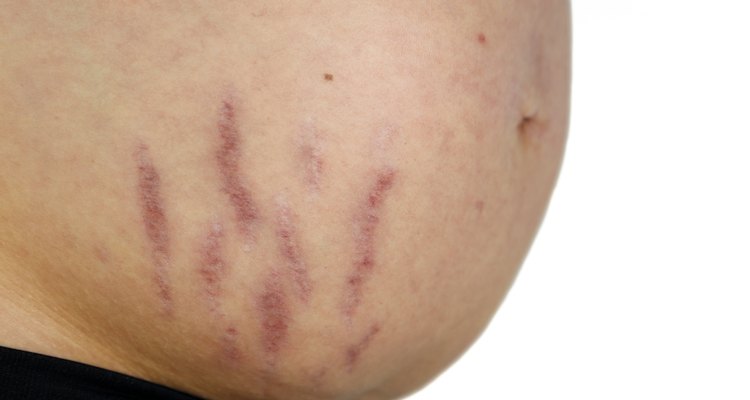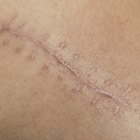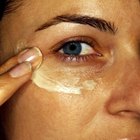
juefraphoto/iStock/Getty Images
When you gain weight, especially a large amount over a short period of time, it's possible to develop stretch marks. Medically known as striae, these irregular areas of skin typically manifest on the breasts, abdomen, thighs and buttocks. After they develop, stretch marks can actually change in color, sometimes taking on a whitish hue.
Identification
White stretch marks are simply older stretch marks that have changed in color. Over time, it isn't uncommon for stretch marks to fade from their original pinkish or purplish color to a more whitish hue, according to the National Institutes of Health. These irregular streaks are often indented and of a different texture than the rest of your skin.
Origin
Much like pink or purple stretch marks, white striae are typically a result of rapid weight gain. As you gain weight, your skin stretches to accommodate the added pounds. After a certain point, your skin is unable to stretch without damaging its elastic fibers. This damage causes elastin and collagen to weaken within the underlying layers of your skin, leaving indented and discolored streaks on the epidermis. They may also develop from the use of steroidal drugs or during puberty due to added height.
Self-Care
Many over-the-counter creams exist that claim to fade stretch marks, but the Mayo Clinic cautions against their use. Though these products don't contain ingredients that are harmful to your skin, they're just unable to provide results. Even topical prescription medications are unable to treat white stretch marks. Tretinoin, a prescription cream often used for acne, is only effective on striae less than six weeks old.
Procedures
To successfully treat older stretch marks, you need to rely on cosmetic procedures. One of the most beneficial is laser therapy. When laser energy is administered over these skin irregularities, it stimulates the production of collagen and elastin, notes the Mayo Clinic. With the added collagen and elastin, the white stretch marks take on a similar appearance to the rest of your skin, making them less visible. As of 2010, there's no method currently available to fully eliminate stretch marks, regardless of their age.
Prevention
There's no surefire way to prevent white stretch marks. However, you can reduce your chances of developing these streaks by maintaining a healthy weight. This is done with a combination of diet and exercise. Even women who are pregnant can work with a doctor to manage weight gain, which may help limit stretch marks, says the Mayo Clinic.
Related Articles

Amino Acids to Get Rid of Acne Scars & ...

What Are the Dangers of Photofacials?

How to Lighten Birthmarks

How to Julienne Jicama

Fraxel Repair Vs. Restore Results

Glycolic Acid for Stretch Marks

How to Heal Old Scars From the Inside ...

The Best Facial Moisturizers for People ...

Do Peels Work for Stretch Marks?

How do I Get White Gold Jewelry to ...

Bleaching Age Spots

How to Even Out Skin Tone Without Makeup

Difference Between Bronzing & Tanning ...

Can Tri-Luma Be Used to Fade Acne Scars?

Removing Acne Scars With Tretinoin Cream

UV Tanning Vs. Spray Tanning

How to Fix the White Spots After a ...

List of Retinoids

White Ink Tattoo Information

How to Get Rid of Stomach Freckles
References
Writer Bio
Based in Minneapolis, Minn., Dana Severson has been writing marketing materials for small-to-mid-sized businesses since 2005. Prior to this, Severson worked as a manager of business development for a marketing company, developing targeted marketing campaigns for Big G, Betty Crocker and Pillsbury, among others.
Photo Credits
juefraphoto/iStock/Getty Images